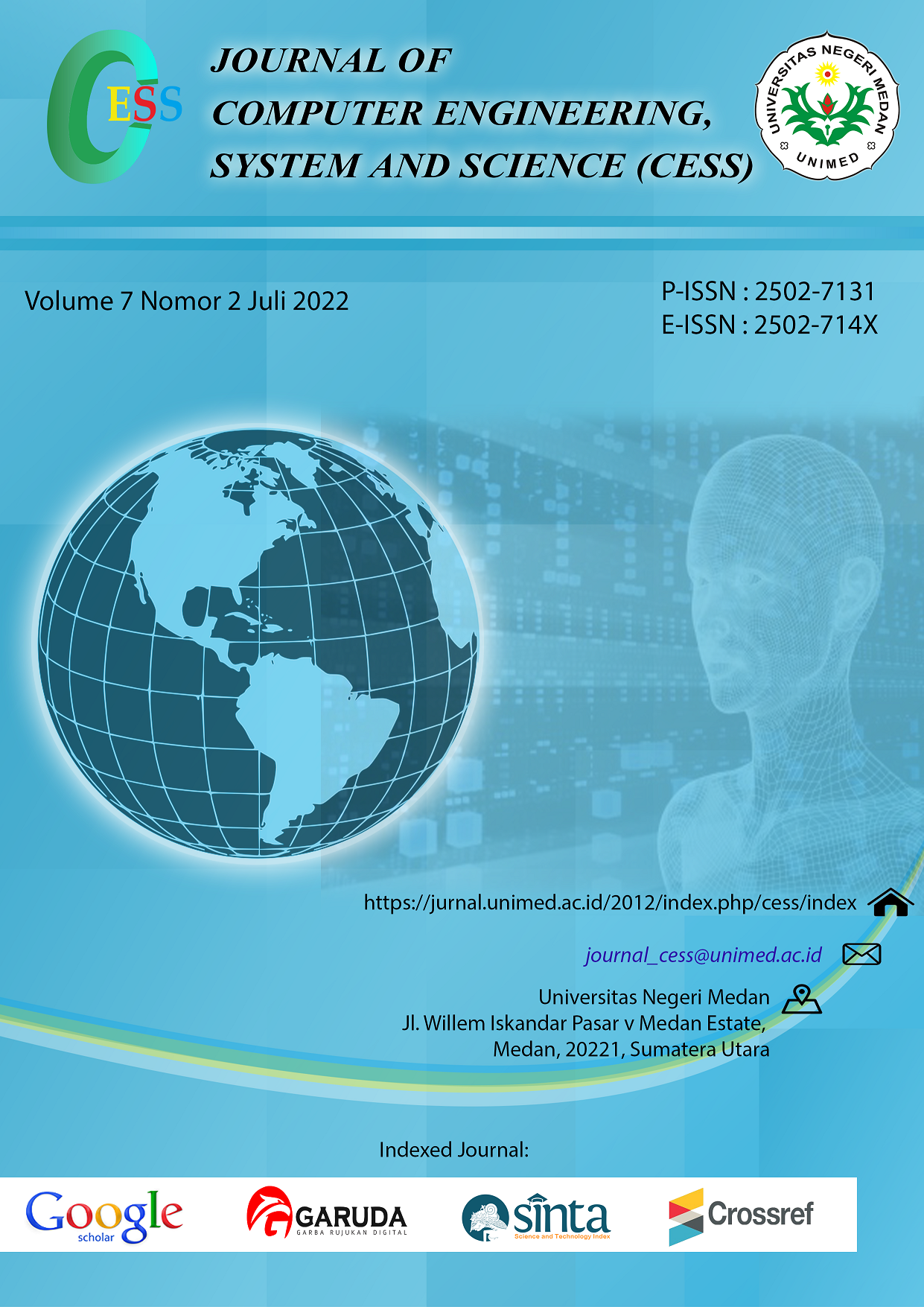Implementation of Random Forest on Face Recognition Using Isomap Features
DOI:
https://doi.org/10.24114/cess.v7i2.34498Keywords:
Pengenalan Wajah, Ekstraksi Fitur, Isomap, Random ForestAbstract
Sistem pengenalan wajah merupakan salah satu bidang yang digunakan untuk mengenali wajah seseorang. Dalam penelitian ini, data yang dikumpulkan merupakan data citra wajah yang terdiri dari 24 citra dengan komposisi 6 orang dan tiap orang memiliki 4 citra dengan berbagai ekspresi. Untuk mengenali wajah tersebut, dilakukan ekstraksi fitur wajah terlebih dahulu menggunakan metode isomap. Isomap merupakan metode reduksi dimensi yang dapat mereduksi dari dimensi tinggi menjadi fitur-fitur yang berdimensi rendah. Berdasarkan hasil ekstraksi diperoleh 4 fitur yang digunakan untuk mengklasifikasikan wajah. Untuk mengklasifikasikan wajah, digunakan algoritma random forest. Berdasarkan hasil penelitian diperoleh tingkat akurasi hasil klasifikasi sebesar 87,5%, nilai weighted average precision sebesar 81,25% dan nilai weighted average recall sebesar 87,5%.Downloads
References
R. Kosasih, œPenggunaan Metode Linear Discriminant Analysis Untuk Pengenalan Wajah Dengan Membandingkan Banyaknya Data Latih, J. Ilm. Teknol. dan Rekayasa, vol. 26, no. 1, pp. 25“34, 2021.
R. Kosasih and C. Daomara, œPengenalan Wajah dengan Menggunakan Metode Local Binary Patterns Histograms ( LBPH ), Media Inform. Budidarma, vol. 5, pp. 1258“1264, 2021, doi: 10.30865/mib.v5i4.3171.
L. Van der Maaten, E. Postma, and J. Van den Herik, œDimensionality Reduction : A Comparative Review, Tilburg, Netherlands, 2009.
J. B. Tenenbaum, V. De Silva, and J. C. Langford, œA Global Geometric Framework for Nonlinear Dimensionality Reduction, Science (80-. )., vol. 290, no. December, pp. 2319“2323, 2000.
Salamun and F. Wazir, œRancang Bangun Sistem Pengenalan Wajah Dengan Metode Principal Component Analysis, J. Teknol. dan Sist. Inf. UNIVRAB, vol. 1, no. 2, pp. 59“75, 2016, doi: 10.36341/rabit.v1i2.25.
P. Rosyani, œPengenalan Wajah Menggunakan Metode Principal Component Analysis (PCA) dan Canberra Distance, J. Inform. Univ. Pamulang, vol. 2, no. 2, p. 118, 2017, doi: 10.32493/informatika.v2i2.1515.
A. Fahrurozi and R. Kosasih, œFace Recognition Using Local Binary Pattern Combined With PCA For Images Under Various Expression and Illumination, in Proceeding on International Workshop on Academic Collaboration 2017, 2017, no. May, pp. 1“7.
R. Kosasih and A. Fahrurozi, œClustering of Face Images by Using Isomap method, in Proceeding on International Workshop on Academic Collaboration 2017, 2017, no. May, pp. 52“56.
R. Kosasih, œKombinasi Metode Isomap dan KNN Pada Image Processing Untuk Pengenalan Wajah, CESS (Journal Comput. Eng. Syst. Sci., vol. 5, no. 2, pp. 166“170, 2020.
S. Menaria and D. Mukherjee, œVideo Manifold Feature Extraction Based on ISOMAP, Int. J. Eng. Sci. Invent., vol. 4, no. 4, pp. 64“67, 2015, [Online]. Available: www.ijesi.org.
V. Y. Kullarni and P. K. Sinha, œRandom Forest Classifier: A Survey and Future Research Directions, Int. J. Adv. Comput., vol. 36, no. 1, pp. 1144“1156, 2013.
A. Krogh and J. Vedelsby, œNeural Network Ensembles, Cross Validation, and Active Learning Anders, pp. 6“7, 2010.
D. Opitz and R. Maclin, œPopular ensemble learning: an empirical study, J. Artif. Intell. Res., vol. 11, pp. 169“198, 1999.
L. Breiman, œBagging predictors, Mach. Learn., vol. 24, no. 2, pp. 123“140, 1996, doi: 10.1007/bf00058655.
R. E. Schapire, œThe Boosting Approach to Machine Learning: An Overview BT - Nonlinear Estimation and Classification, Nonlinear Estim. Classif., vol. 171, no. Chapter 9, pp. 149“171, 2003, [Online]. Available: http://link.springer.com/10.1007/978-0-387-21579-2_9%0Apapers3://publication/doi/10.1007/978-0-387-21579-2_9.
M. Reza, S. Miri, and R. Javidan, œA Hybrid Data Mining Approach for Intrusion Detection on Imbalanced NSL-KDD Dataset, Int. J. Adv. Comput. Sci. Appl., vol. 7, no. 6, pp. 1“33, 2016, doi: 10.14569/ijacsa.2016.070603.
J. Ali, R. Khan, N. Ahmad, and I. Maqsood, œRandom forests and decision trees, IJCSI Int. J. Comput. Sci. Issues, vol. 9, no. 5, pp. 272“278, 2012.
I. Amalia, œPengenalan Citra Tanda Tangan Menggunakan Gray Level Co-Occurrence Matrix (GLCM) Dan Probabilistic Neural Network (PNN), E-Jurnal Politek. negeri Lhokseumawe, vol. 14, pp. 29“34, 2014.
L. A. Septiandi, E. M. Yuniarno, and A. Zaini, œDeteksi Kedipan dengan Metode CNN dan Percentage of Eyelid Closure (PERCLOS), Tek. Its, vol. 10, no. 1, pp. A56“A57, 2021.
T. Yulianti, M. Telaumbanua, H. D. Septama, and H. Fitriawan, œPengaruh Seleksi Fitur Citra Terhadap Klasifikasi Tingkat the Effect of Image Feature Selection on the Local Beef, vol. 10, no. 1, pp. 85“95, 2021.
D. P. Lestari, R. Kosasih, T. Handhika, Murni, I. Sari, and A. Fahrurozi, œFire Hotspots Detection System on CCTV Videos Using You only Look Once (YOLO) Method and Tiny YOLO Model for High Buildings Evacuation, in 2nd International Conference of Computer and Informatics Engineering IC2IE, 2019, pp. 87“92.
M. Sokolova and G. Lapalme, œA Systematic Analysis of Performance Measures for Classification Tasks, Inf. Process. Manag., vol. 45, no. 4, pp. 427“437, 2009.
Downloads
Published
How to Cite
Issue
Section
License
Copyright (c) 2022 CESS (Journal of Computer Engineering, System and Science)

This work is licensed under a Creative Commons Attribution 4.0 International License.















